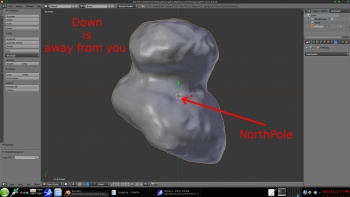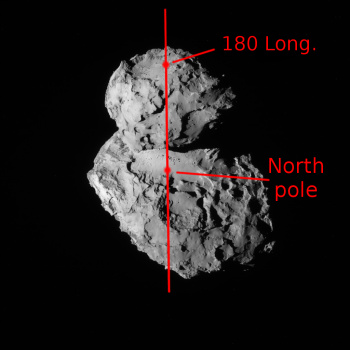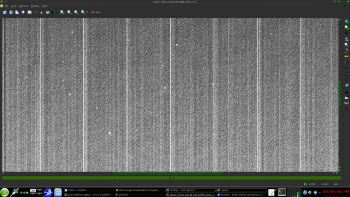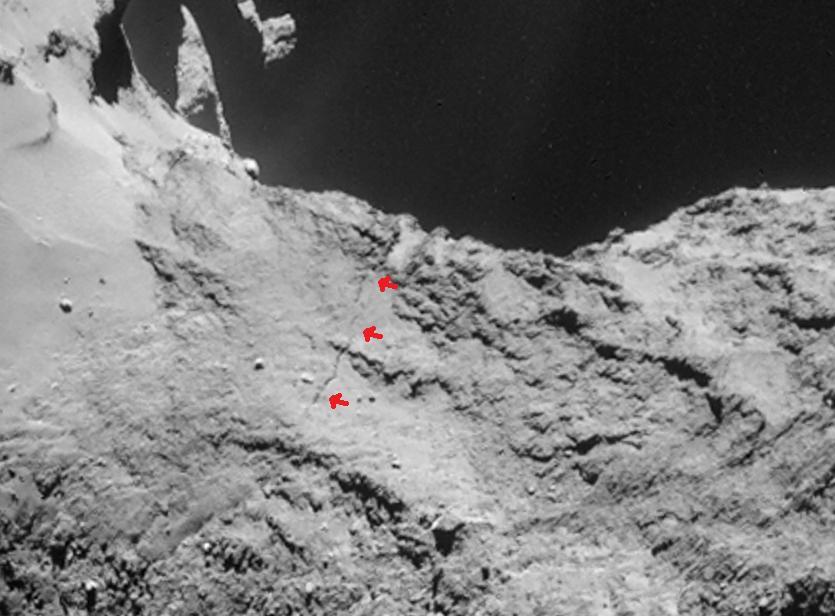Delurking for a moment to ask a question: I'm struggling to understand the orbital maneuvering that Rosetta needs to do to release the unpowered Philae probe on the correct trajectory. Is Rosetta momentarily heading straight toward the landing site?
Is there an animation anywhere that shows this? I'm thinking of something like Doug's amazing animation of the MSL EDL..
Full Version: Rosetta - Early Orbital Operations at Comet 67P C-G
(below left) interesting bright circular patch at top right in sept 10 release.
Nice resolution in this release, also nice is the subtle illumination of the dark inner-facing 'side' between the two lobes.
the same area is covered on sept 1 aug 16 aug 8 aug 3, but the aug 7 release has it (below right), seems theres nothing there, perhaps a sort of camera artifact?
Nice resolution in this release, also nice is the subtle illumination of the dark inner-facing 'side' between the two lobes.
the same area is covered on sept 1 aug 16 aug 8 aug 3, but the aug 7 release has it (below right), seems theres nothing there, perhaps a sort of camera artifact?
The ESA blog provides some explanation:
QUOTE
We too were curious and looked at an image taken earlier and it was not visible (the shadow beneath it is coincidence; this is also seen in images without the object). Therefore it is most likely either an image artefact or a transient object in the foreground.
Indeed, if you adjust the contrast of the image you will see that there is a lot of ‘noise’ in the background. Some of this is simply detector noise and cosmic rays, but there seem to be a few bright objects that may be dust/ice particles between Rosetta and the comet.
In previous NAVCAM and OSIRIS images, we’ve already seen jets of gas laced with dust streaming away from the comet, and the instruments COSIMA and GIADA have started detecting dust, so it would be no surprise if these objects were also found to originate from the comet. In any case, it is a phenomenon that will clearly be studied in great detail at 67P/C-G over the coming weeks and months.
Indeed, if you adjust the contrast of the image you will see that there is a lot of ‘noise’ in the background. Some of this is simply detector noise and cosmic rays, but there seem to be a few bright objects that may be dust/ice particles between Rosetta and the comet.
In previous NAVCAM and OSIRIS images, we’ve already seen jets of gas laced with dust streaming away from the comet, and the instruments COSIMA and GIADA have started detecting dust, so it would be no surprise if these objects were also found to originate from the comet. In any case, it is a phenomenon that will clearly be studied in great detail at 67P/C-G over the coming weeks and months.
But it would be nice to hear our members' opinions.
Here's a pixel-resized NAVCAM image:
Click to view attachment
Delurking for a moment to ask a question: I'm struggling to understand the orbital maneuvering that Rosetta needs to do to release the unpowered Philae probe on the correct trajectory. Is Rosetta momentarily heading straight toward the landing site?
No they speed up Rosetta, so it would actually leave the comet, push the lander backwards away from Rosetta, the comet catches up with the lander and it lands. Rosetta in the mean time has to do a slow down maneuver to keep flying along side the comet. Impact with the comet is 1 meter per second, nice and slow.
But it would be nice to hear our members' opinions.
I had also looked closely and decided it had no characteristics of an object on the surface. I think the ESA analysis is correct--get ready for a party of these fireflies: http://www.nasa.gov/mission_pages/epoxi/images/pia13622.html
The Vents of Chur-Ger
Click to view attachment
Watch Video in ths BBC ROSETTA news release where Imaging leader Holger Sierks points these out. Areas where venting is ocurring now. PHILAE lander will come down close to these.
http://www.bbc.com/news/science-environment-29203284
Awesome!
Craig
Click to view attachment
Watch Video in ths BBC ROSETTA news release where Imaging leader Holger Sierks points these out. Areas where venting is ocurring now. PHILAE lander will come down close to these.
http://www.bbc.com/news/science-environment-29203284
Awesome!
Craig
No they speed up Rosetta, so it would actually leave the comet,
No - it's pretty clear from their artwork, from what they said during the press conference, and from the SPICE trajectory we've put into Eyes on the Solar System - they put the orbiter on a collision course with the nucleus - approach for a couple of hours, deploy Philae - carry on following for about another half hour - do a divert burn and then try to image Philae.
it would be nice to hear our members' opinions.
If that was a dust/ice particle between Rosetta and the comet, my guess is it would have to be quite large and far away otherwise there would be motion blur. But we can imagine trying to quantify this as follows:
I don't know if we have exposure information, but given the darkness of the comet the exposure is probably on the long side. Someone here can probably estimate the expected order-of-magnitude relative speeds between Rosetta and dust particles in its immediate vicinity. Combining order-of-magnitude exposure length and relative speed with the lack of obvious trailing in the image would then put an order-of-magnitude lower limit on the distance (and hence on the size) of a putative snowflake. This of course would ignore the unlikely situation where the snowflake was moving essentially directly towards the camera. And any particle-size dependence on the velocities could in principle be factored into the calculation.
A detail about the Philae release: If Philae will be released for site J, the release velocity will be 18 cm/s:
Philae Blog 1:
Philae Blog:
Philae Blog 1:
QUOTE
So, it [site J] has a safe delivery trajectory, it allows the safe release scenario of the lander (nominal and emergency release with the same velocity), provides a descent to the surface in a little more than 7 hours with the second highest touch-down probability.
Philae Blog:
QUOTE
One needs to know that the lander release uses two different ejection mechanisms one after the other, the so called nominal ejection which is adjustable up to speeds of 50 cm/s and the emergency release which has a fixed ejection speed of 18 cm/s.
Areas where venting is ocurring now. PHILAE lander will come down close to these.
Close on a global scale, but it looks like these vents would be well around the lobe and so thoroughly over the horizon from the primary landing site. I've circled the vents on this image from Emily's landing site album:
Click to view attachment
Of course any jets might still be visible rising above the horizon...
Perhaps these vents are the source of the jets we saw emitted from the neck region earlier?
Edit: S+T incorrectly identifies a pair of boulders as the pits here!
No wonder I had a hard time seeing them in the landing zone. In the video Holger Sierks mentioned the ones he pointed out were 500-600 meters from the landing area. He did not say whether he meant the ellipse or the x-marks the spot point. If he meant that x point then that might put them inside the J landing ellipse.
Anyway that puts the lander close to an active region.
Anyway that puts the lander close to an active region.
...they put the orbiter on a collision course with the nucleus - approach for a couple of hours...
From the landing selection video after 1:09 there is this:"To deliver the lander successfully, we have to fly relatively fast in front of the comet and this brings the spacecraft again on hyperbolic orbit so we are not bound any more to the gravity of the comet."
I don't get the impression from this description of the pre-release maneuver that Rosetta will be put on a collision course with the comet.
...this brings the spacecraft again on hyperbolic orbit so we are not bound any more to the gravity of the comet."
I don't get the impression from this description of the pre-release maneuver that Rosetta will be put on a collision course with the comet.
I don't get the impression from this description of the pre-release maneuver that Rosetta will be put on a collision course with the comet.
I don't know who's right (I tend to believe Doug) but these statements aren't mutually exclusive: you can be in a hyperbolic escape orbit and on a collision course at the same time.
Would it need to be sent on a collision course? Wouldn't a near-collision course be sufficient, given that the comet has at least a little gravity with which to deviate Philae from Rosetta's path?
From the landing selection video after 1:09 there is this:
"To deliver the lander successfully, we have to fly relatively fast in front of the comet and this brings the spacecraft again on hyperbolic orbit so we are not bound any more to the gravity of the comet."
"To deliver the lander successfully, we have to fly relatively fast in front of the comet and this brings the spacecraft again on hyperbolic orbit so we are not bound any more to the gravity of the comet."
The quote you cite sounded to me like they were talking about the fly-away burn after deployment.
Again - refer to that drawing I grabbed from the conference - it's quite clear that they in essence do a pseudo 'deorbit' burn - separate the lander, and then do a divert burn to avoid following the lander into the comet.
Also from the press event.... "We are in orbit around the comet. We interrupt this orbit - we fly closer to the comet, we go downwards, we release the lander" and also "We phase the orbit of the spacecraft to meet the landing site"
Put it this way - let's conduct a thought experiment where they don't do a divert for the orbiter 30 mins after the separation.
The 18cm/sec separation speed, allowing for a 12:1 mass ratio between the 100kg lander and the approx 1200kg dry mass of Rosetta
This means Philae will be pushed forward at 16.6cm/sec and Rosetta pushed backwards at 1.4cm/sec ( roughly )
So after 7 hours, Rosetta will be 0.3km in one direction - the lander 4.1km in the other. The comet is approx 3 x 4km. If you had perfect navigation - and aimed such that the lander were aimed at the center of a 3.5km sphere..... the orbiter would swoop over the comet at an altitude of only 2.6km - way closer than they would normally fly the orbiter, especially given that in the conference they stated the difference in accuracy between orbit reconstruction and orbit prediction is about 1km.
So - is it an exact collision course? No. But it would be a damn close flyby if they didn't divert the orbiter 30 minutes after separation. DAMN close.
Most meteors colliding with Earth are probably gravitationally unbound to Earth, and hence on "hyperbolic escape orbits". It just means that if there somehow was a vacuum tunnel through the Earth along the meteoroid's original trajectory, it would pass through and leave Earth completely.
About the Rosetta near-collision course, presumably that's just a matter of limits on the kick (delta v) that can be imparted to the lander. In other words, the orbiter must be on close to a collision course with the comet when it releases the lander, simply because it can't impart too much of a kick to the lander.
Would it need to be sent on a collision course? Wouldn't a near-collision course be sufficient, given that the comet has at least a little gravity with which to deviate Philae from Rosetta's path?
Gravity has a nice property known as the equivalence principle. Gravity will deviate the lander and the orbiter in exactly the same way. The only way to not have both follow the same trajectory (Edit: ignoring any drag effects from the coma) is for the orbiter to impart a kick to the lander.About the Rosetta near-collision course, presumably that's just a matter of limits on the kick (delta v) that can be imparted to the lander. In other words, the orbiter must be on close to a collision course with the comet when it releases the lander, simply because it can't impart too much of a kick to the lander.
There is not 100% guarantee that the Philae would be land exactly on the same place. Most says, the success rate would be less than 51%. In order to improve the landing success on a very narrow elliptical, needs a previous practice. No obstante, for this case, it is impossible to perform unless to do it only once time without any mistakes! An very important factor is about how fine is the Rosetta's navigation maneuver control. This is the aim to put the lander Philae on the J site, on head of comet.
The rotation axis of comet (North and South pole) is in the lower part of neck, close to the bigger head. Now, by observing the pictures, I may fail it, the sun direction is almost perpendicular to the rotation axis? The direction in which the comet flies thru the space is on the same line to the rotation axis?
The rotation axis of comet (North and South pole) is in the lower part of neck, close to the bigger head. Now, by observing the pictures, I may fail it, the sun direction is almost perpendicular to the rotation axis? The direction in which the comet flies thru the space is on the same line to the rotation axis?
I've put a red oval on the closeup view of the landing area that approximates the oval landing area on the global view.
Click to view attachment
Click to view attachment
QUOTE
The rotation axis of comet (North and South pole) is in the lower part of neck, close to the bigger head. Now, by observing the pictures, I may fail it, the sun direction is almost perpendicular to the rotation axis? The direction in which the comet flies thru the space is on the same line to the rotation axis?
the Northpole and the axis of rotation


( PS the "down" is in reference to "down as in south ? " for a question that was asked )
the NP is in the second pic
and shown here

Ever since they started posting the 4-quadrant NavCam images, there has been a visible vertical striping in the background, which you have to correct if you want to process the images to reveal faint things like jets. It's very faint -- the stripes rise about 4 DN above the background -- but it shows up in images stretched to reveal jets. I've been assuming that it was like the striping in Cassini images, which varies from image to image. But I just realized this morning that the stripes are in the same positions from one image to the next, which means that instead of correcting them one image at a time, what I really need to do is to develop a NavCam flatfield and apply it to all images as they come in. One could cobble a flat field together using sections of photos that show mostly black sky, stacking them to remove JPEG artifacts, and deleting cosmic rays, but it will take a lot of work. Before I spend any more time working on this, I thought I'd check to see if anyone else has tried to make a flat field for the NavCam images...
(Edit: added an insanely stretched NavCam photo to show what I'm talking about)
(Edit: added an insanely stretched NavCam photo to show what I'm talking about)
Ever since they started posting the 4-quadrant NavCam images, there has been a visible vertical striping in the background, which you have to correct if you want to process the images to reveal faint things like jets. It's very faint -- the stripes rise about 4 DN above the background -- but it shows up in images stretched to reveal jets. I've been assuming that it was like the striping in Cassini images, which varies from image to image. But I just realized this morning that the stripes are in the same positions from one image to the next, which means that instead of correcting them one image at a time, what I really need to do is to develop a NavCam flatfield and apply it to all images as they come in. One could cobble a flat field together using sections of photos that show mostly black sky, stacking them to remove JPEG artifacts, and deleting cosmic rays, but it will take a lot of work. Before I spend any more time working on this, I thought I'd check to see if anyone else has tried to make a flat field for the NavCam images...
(Edit: added an insanely stretched NavCam photo to show what I'm talking about)
(Edit: added an insanely stretched NavCam photo to show what I'm talking about)
Here you go. BlackCurrent images for NAVCAM. Subtract these from your images and you should be fine. You need to work in linear not sRGB.
These should work pretty well in most apps. one 16 bit and one 32bit.
http://mattias.malmer.nu/wp-content/upload...ckcurrent32.tif
http://mattias.malmer.nu/wp-content/upload...lackcurrent.tif
I should do flatfields aswell at some point...
How did you generate these black current images, Malmer?
It has only this moment occurred to me that there is public archival NavCam data from which one could generate flatfields like this....I'm an idiot.
Well, I found the NavCam data, and it does have faint vertical striping, but it doesn't look the same to me as what I'm seeing in the C-G images. I'm a little bit out of my depth here. Maybe it's already been flatfielded?
How did you generate these black current images, Malmer?
A bit of weighted averaging of the "non comet" parts of a bunch of navcam images. Then some trixy filtering to remove any influences from whatever coma and dust and rayhits that might have snuck in. I would do it this a bit more seriously with real EDR:s but for the raw JPG:s it will probably be enough. Use them at your own risk as it where
The navcam have some salt and pepper pixel errors aswell (they seem to remove that from modt of the JPG images they release) It is a static error but it is a bit strange. One pixel gets brighter and the one over or under it gets darker. It seems they have a good model to remove it with.
I'm reconstructing rosettas position and pointing in relation to the comet for all the released images. We are really getting quite close...
The three brown cameras are three of the four images in the quartet in the latest "Comet on 14 September 2014 - NavCam" release. (the fourth image had to few surface features to match on so I could not get a proper solve for that image.)
Click to view attachment
The three brown cameras are three of the four images in the quartet in the latest "Comet on 14 September 2014 - NavCam" release. (the fourth image had to few surface features to match on so I could not get a proper solve for that image.)
Click to view attachment
the virt lines are clearly visable inthis PDS image
ROS_CAM1_20080904T150502
-- screenshot from ISIS3 - Qview

---- EDITED LATER-----
grabed the older PDS archive
http://sbn.pds.nasa.gov/draft/Rosetta/NAVC...ST1-V1.0.tar.gz
a zip file containing 2 32 bit floating point images and a preview normalized 0-255 pgm of each
https://googledrive.com/host/0B6ZYAd08tZL-V...amVertLines.zip
-- 8 bit previews


ROS_CAM1_20080904T150502
-- screenshot from ISIS3 - Qview

---- EDITED LATER-----
grabed the older PDS archive
http://sbn.pds.nasa.gov/draft/Rosetta/NAVC...ST1-V1.0.tar.gz
a zip file containing 2 32 bit floating point images and a preview normalized 0-255 pgm of each
https://googledrive.com/host/0B6ZYAd08tZL-V...amVertLines.zip
-- 8 bit previews


CODE
used this
--
"pds2isis"
"dstripe"
then
"gdal_translate"
--
"pds2isis"
"dstripe"
then
"gdal_translate"
How many images are they currently taking per day with OSIRIS? In the ESA presentation for the landingsite they showed sequences of images taken very close in time after oneanother. Are they doing that more or less continuously or is it more of a burst thing?
Mosaic of 4 NavCam pictures taken on September 14th.
Very nice mosaic! Some of these days I´ll need to print a large poster of the comet for my wall
Click to view attachment
It looks like the smooth material forms linear/curvilinear reliefs, like dunes (!).
In terms of cometary processes rather than Earth's processes, these wrinkle ridges may be due to surface area shrinkage as material beneath is lost, or to tectonics (shifting of material inside the comet) or even some earlier impact event.
Oooh! Nice picture of jets coming out of the neck region.
http://www.esa.int/spaceinimages/Images/20...ber_2014_NavCam



http://www.esa.int/spaceinimages/Images/20...ber_2014_NavCam
Not only the neck - it looks like faint activity coming from the bigger lobe, too:
Click to view attachment
Click to view attachment
these wrinkle ridges may be due to surface area shrinkage as material beneath is lost, or to tectonics [...]
My background assumption was that this material is very loose, so thrust faults and wrinkle ridges could not form on it. On the other hand, if they can, surface shrinkage as you suggested, or surface shaking could be responsable for their formation.
How many images are they currently taking per day with OSIRIS? In the ESA presentation for the landingsite they showed sequences of images taken very close in time after oneanother. Are they doing that more or less continuously or is it more of a burst thing?
They haven't published these information. H. Sierks stated in the last broadcast that they are taking sequences of images from week to week or even 2 weeks cadence.
But from documents which I saw it looks that OSIRIS works mostly every day with occasional two days pause. Longer pause is probably uncommon.
Some sequences are devoted to dust and coma studies, some for color imaging, some for 3D reconstruction of the cometary nucleus and surface (landing sites) and some for navigation (WAC).
How many images are in every sequence I don't know exactly.
But my guess is from 8 to 24 full scale (4 Mpix lossless compression) images every imaging day (it can be much more in case of lossy compressed and subframe images).
We will see next year.
Also you can get a sense of the 3-dimensional location of the vents - the left arrow points to a dark shadowed region, but the right arrow point to a shadowed region with visible venting in front of it. That means the venting is between the two shadowed regions.
Click to view attachment
Edit: unless in the brighter shadowed regions the ground is being illuminated by scattered light from the sunlit areas, although it would be a coincidence that the resulting brightness matches that of the jets so well.
Click to view attachment
Edit: unless in the brighter shadowed regions the ground is being illuminated by scattered light from the sunlit areas, although it would be a coincidence that the resulting brightness matches that of the jets so well.
I finally did what I should have done in the first place, and made my own NavCam flat field. It's not perfect but it does a surprisingly good job of correcting NavCam images.
Here is the neck in detail:

It seems, that the neck is broken... maybe Tschurri break off the next months .. years .. hundred years ?
Would be cool to see.

It seems, that the neck is broken... maybe Tschurri break off the next months .. years .. hundred years ?
Would be cool to see.
Well spotted!
The concave 'interior' side of the neck must be under compression and the other side under tension, so maybe this is a tension crack. It's tempting to let your eye continue that line further down the image, even if the feature looks less fresh there.
The concave 'interior' side of the neck must be under compression and the other side under tension, so maybe this is a tension crack. It's tempting to let your eye continue that line further down the image, even if the feature looks less fresh there.
Here is the neck in detail:

It seems, that the neck is broken... maybe Tschurri break off the next months .. years .. hundred years ?
Would be cool to see.

It seems, that the neck is broken... maybe Tschurri break off the next months .. years .. hundred years ?
Would be cool to see.
I noticed that also. If Rosetta gets to watch C-G come apart, it would be glorious! (Okay, would probably mean EOM, but what a way to go!)
Also noticing the absence of the large debris Deep Impact saw being ejected from Hartley (I hope I've got the right comet--amazing we've seen so many in the last few years I'm getting them confused!). Wondering if C-G will produce such things closer to perihelion.
Jeff
tension perhaps from uneven gravitation caused by uneven outgassing? if that were enough..
The jets seem so pin-point sourced, id expect to find voids at their origin, not just the progressive neck-thinning that seems the apparent result. many competing processes going on no doubt.
with all the crazy shadowing, im again confused what side is which, but the 'crack' may have also been visible in the aug 8th release and the aug 3 release
The jets seem so pin-point sourced, id expect to find voids at their origin, not just the progressive neck-thinning that seems the apparent result. many competing processes going on no doubt.
with all the crazy shadowing, im again confused what side is which, but the 'crack' may have also been visible in the aug 8th release and the aug 3 release
Oooh! Nice picture of jets coming out of the neck region.
And I've never seen a better picture OR attendant quote to validate something this comet has reminded me of all along: Not a duck!
My background assumption was that this material is very loose, so thrust faults and wrinkle ridges could not form on it. On the other hand, if they can, surface shrinkage as you suggested, or surface shaking could be responsable for their formation.
The mentions of dark, organic material does have me wondering whether this covering is more tar-like than loose and dusty? I've imagined it to be more like a parking lot in color and composition.
A dark carbon crust means it's been under the toaster before: this is not its first visit to the inner solar system. These bodies must experience small perturbations whilst far from the sun. An interesting question is whether this perihelion will be closer than previous ones. If so I think we can expect big events, if not then maybe only incremental change.
This is a "lo-fi" version of our main content. To view the full version with more information, formatting and images, please click here.


